Starfish are iconic marine creatures that every child learns to draw as soon as they are given crayons and a picture! Small wonder aquarists around the world love nothing better than to buy a Starfish for their first saltwater tank.
However, not every Starfish is right for the eager beginner. Most are quite sensitive, even for invertebrates, and minor changes in water chemistry can lead to death within hours.
Others have strange eating habits. Starfish feed on everything from coralline algae to slow moving fish. I think it’s best if we get to know some of the most common types of aquarium Starfish in the trade before you make a purchase!
Saltwater Starfish for Aquariums: Popular Species
Here are a few types of aquarium starfish found in the hobby. Keep in mind that some of these are extremely hard to keep – make sure to check our difficulty rating before making any purchases at your local fish store!
Chocolate Chip Starfish
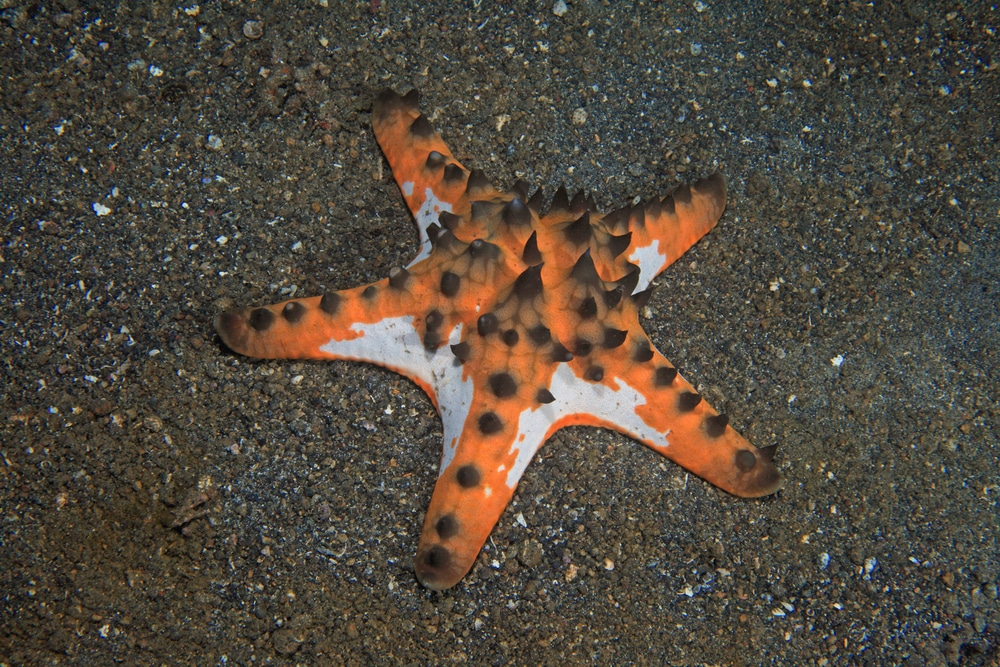
Chocolate Chip Starfish are instantly recognizable thanks to their knobby spines, also earning them the name Knobby Starfish. These IndoPacific Starfish are found in warm, shallow waters across the region and are the most common type of aquarium Starfish to find in pet stores.
Chocolate Chip Starfish are one of the few truly beginner level species. All Starfish are on the sensitive side when it comes to water quality however Chocolate Chip Starfish will do well so long as you keep water parameters stable and clean.
They are also vigorous eaters – simply place cut fish and shellfish nearby and watch as the Starfish moves over the food to consume it. Chocolate Chip Starfish are favorites of aquarists as they are definitely on the active side!
Even after a heavy feeding they will continue to prowl about for food. However, their hearty appetites and large adult diameter makes them a danger to sessile invertebrates such as corals and anemones. They are definitely not a reef-safe type of aquarium Starfish!
- Scientific Name: Protoreaster nodosus
- Origin: IndoPacific
- Diameter: Up to 15 inches
- Difficulty: Easy
- Reef Safe: No
Luzon Starfish
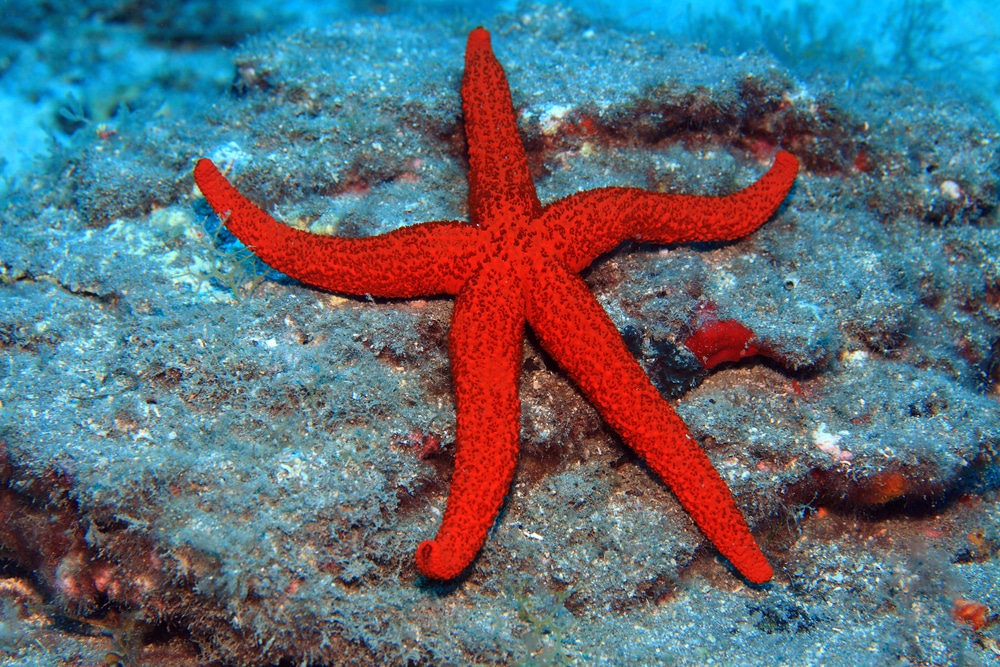
Luzon Starfish are one of the stranger types of aquarium Starfish. For starters they reproduce completely asexually; they split off arms that then regrow into entirely whole Starfish!
They are also home to several organisms. Parasitic limpets sometimes attach to them, as do commensal copepods and even a species of Comb Jellyfish! Most aquarium specimens won’t come with hitchhikers, however.
While not terribly difficult to care for, Luzon Starfish do have a highly specialized diet. They are detritivorous – meaning they feed on algae, microorganisms, biofilms, and tiny invertebrates that coat hard surfaces in marine environments.
Since they won’t accept chunks of flesh like predatory Starfish, they need to be kept in mature reef aquariums and other ecosystems that can support their grazing habits. Since they are on the smaller side Luzon Starfish can usually find enough biofilms to consume in medium to large reef tanks!
- Scientific Name: Echinaster luzonicus
- Origin: Western IndoPacific
- Diameter: 5 inches
- Difficulty: Easy
- Reef Safe: Yes
Brittle Starfish
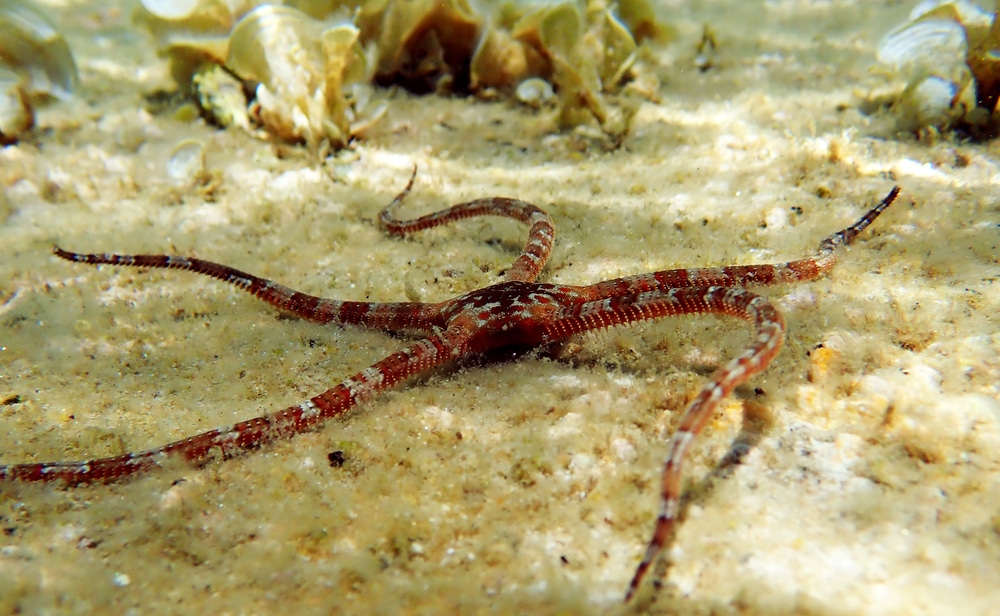
Brittle Starfish are quite distinct from other types of aquarium Starfish. They get their name from their fragile, easily broken limbs that serve the same purpose as a lizard’s tail. When severed, it thrashes, distracting predators while the main organism escapes, only to later regenerate the lost limb.
Brittle Starfish are great choices for aquarists who want more active invertebrates. They can move fairly swiftly on their long, tentacle-like limbs and many species reach a foot in diameter. Many Brittle Starfish come as unexpected hitchhikers when fresh live rock is purchased.
Fortunately, they are usually harmless hitchikers! Most Brittle Starfish are detrivores that hunt for leftover food and tiny invertebrates hidden in rock crevices. However they should be regularly offered chopped or fine meaty offerings such as Brine Shrimp and Tubifex to supplement their scavenging.
Brittle Starfish are usually nocturnal and hide themselves during the day. However the scent of food will usually encourage them into the open!
- Scientific Name: class Ophiuroidea
- Origin: Worldwide
- Diameter: Up to 12 inches
- Difficulty: Easy
- Reef Safe: Yes
Green Brittle Starfish
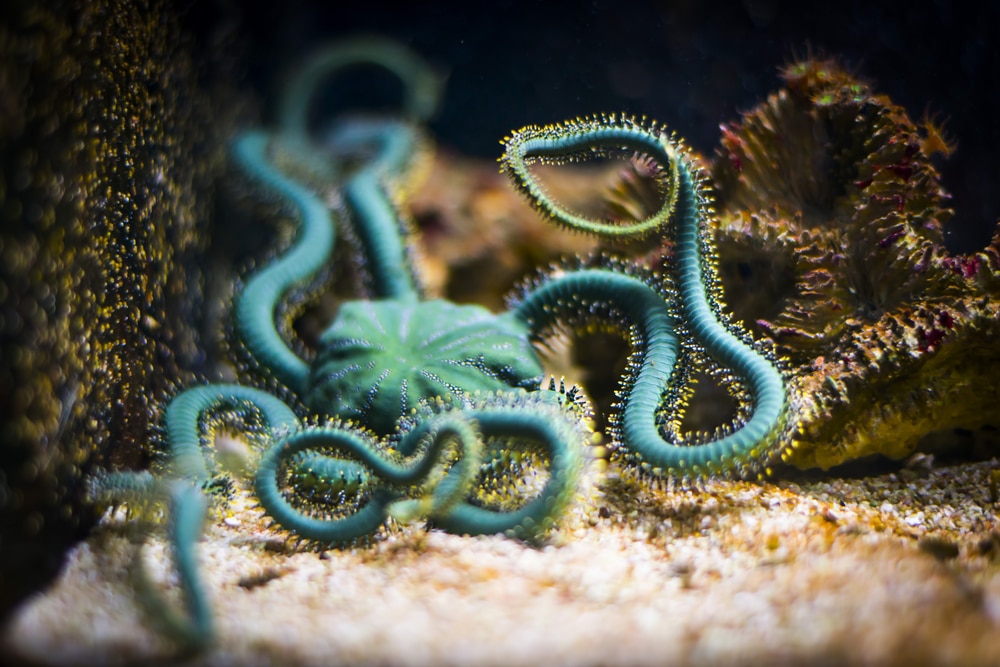
Green Brittle Starfish deserve special mention because they are not as well mannered as their cousins. These large, thick-limbed Starfish are the lions of the Echinoderm world.
Not content to simply graze on detritus and chopped fish, Green Brittle Starfish are active hunters that will snag slow moving fish and invertebrates such as shrimp and crabs.
They do have a weak grip and their small central body prevents them from consuming medium sized prey. However small bottom dwelling fish such as Gobies are at risk, especially when sleeping – the time Brittle Starfish tend to be most active.
As active and large as they are, Green Brittle Starfish require at least 55 gallons of space. They are reef safe in that they won’t harm corals and other sessile invertebrates. However they are a threat to shrimp and other reef inhabitants so exercise caution when keeping Green Brittle Starfish!
- Scientific Name: Ophiarachna incrassata
- Origin: IndoPacific
- Diameter: 12 inches
- Difficulty: Easy
- Reef Safe: With Caution
Double Star Starfish
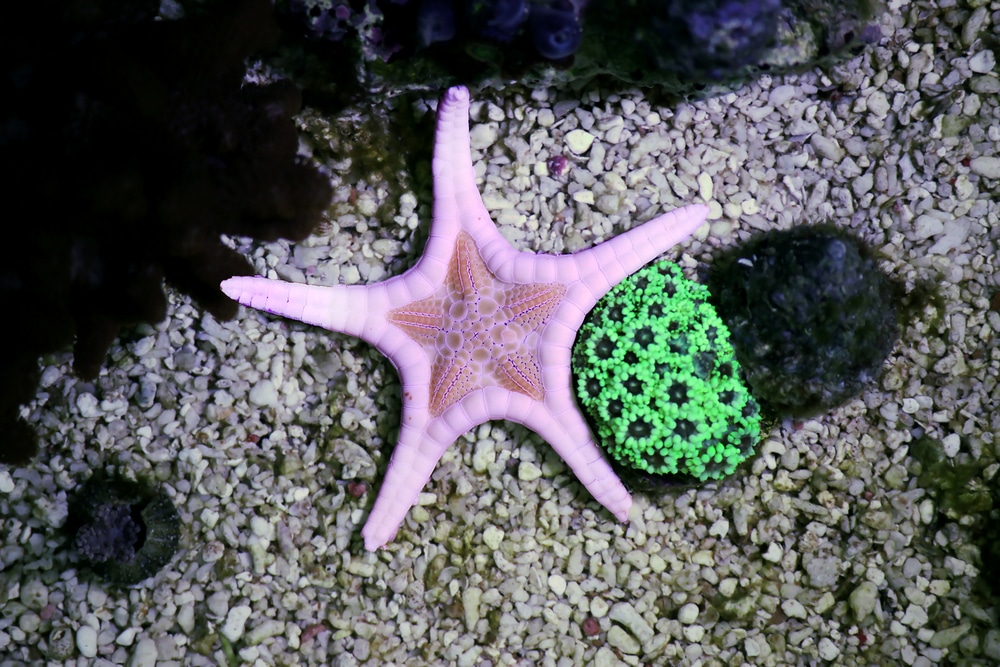
Double Star Starfish are an enigma because they are incredibly sensitive to fluctuations in water chemistry. They need to be kept in mature aquariums where water changes are small and carefully monitored to avoid shocking them to death.
Feeding is also a challenge; even when offered a variety of prepared and meaty items Double Star Starfish can mysteriously die of starvation, disease, shock, or other issues.
They are an expert level type of aquarium Starfish, which is unfortunate because they have a unique pattern and colors that vary considerably among individuals. Some have bright orange inner stars with dark red outer patterns, others are red inside and green without, others still varying shades of green and blue!
If they weren’t so delicate they would easily be the most popular aquarium Starfish. As it stands, they are something of a gamble even for experienced aquarists running mature ecosystems.
- Scientific Name: Iconaster longimanus
- Origin: IndoPacific
- Diameter: 12 inches
- Difficulty: Difficult
- Reef Safe: Yes
Blue Linckia Starfish
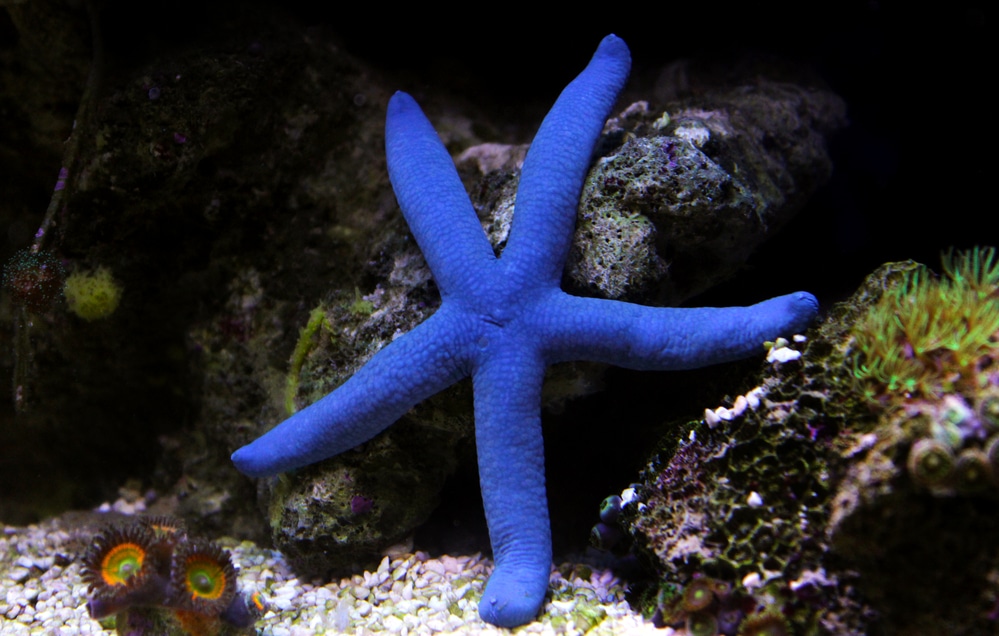
While not especially expensive or difficult to find, Blue Linckia Starfish are one of the worst types of aquarium Starfish for beginners to start with.
For one, they handle the stress of being shipped from the ocean to a pet store extremely poorly. Usually they show up with faded to white patches, a sure sign they will eventually turn white and disintegrate in days to weeks.
Blue Linckia Starfish should also be looked over for infections of Thyca crystallina, a tiny parasitic snail species. These snails gather around the mouth underneath the body of the Starfish and drink bodily fluids from their host.
Enough of these snails can weaken their already delicate constitutions and lead to the death of you new starfish. Assuming you find a Linckia with few parasites and a healthy constitution, they should be drip-acclimated slowly to introduce them to the water parameters of their new home.
Once your healthy specimen is established they can be moderately hardy so long as water conditions remain stable. Blue Linckia Starfish are detritivores and need a mature aquarium that grows coralline algae, brown diatoms, bacterial biofilms, and other live rock coatings for them to slurp up!
As stunningly colored as they are, Blue Linckia Starfish are showpiece invertebrates for healthy reef ecosystems!
- Scientific Name: Linckia laevigata
- Origin: IndoPacific
- Diameter: 12 inches
- Difficulty: Difficult
- Reef Safe: Yes
Marble Starfish
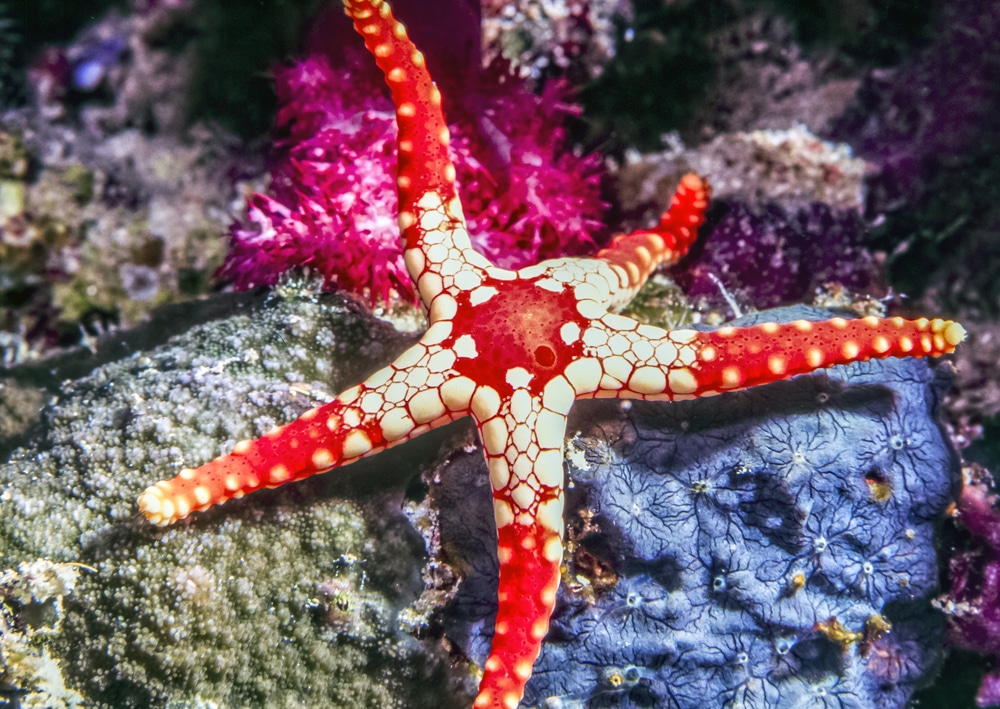
Marble Starfish is a catchall term for a variety of species within the genus Fromia. All of them are closely related and share a similar pattern that varies in color between species.
Overall, Marble Starfish are a great choice for aquarists with large, established reef aquariums that grow enough biofilm to keep them happy. As a general rule, detritivorous Starfish should be kept in larger aquariums.
Large aquariums buffer swings in water conditions better and are more productive at growing algae and bacteria for your Starfish to consume. Marble Starfish will also accept pureed meaty items suspended in a gel or similarly fine suspensions of food.
Once established and fed properly Marble Starfish are relatively hardy and long lived! As a smaller type of aquarium Starfish they can work in smaller aquariums, however your water chemistry needs to be impeccably monitored to avoid lethal swings.
- Scientific Name: Fromia species (usually elegans or monilis)
- Origin: IndoPacific
- Diameter: 6 inches
- Difficulty: Moderate
- Reef Safe: Yes
Red Knobbed Starfish
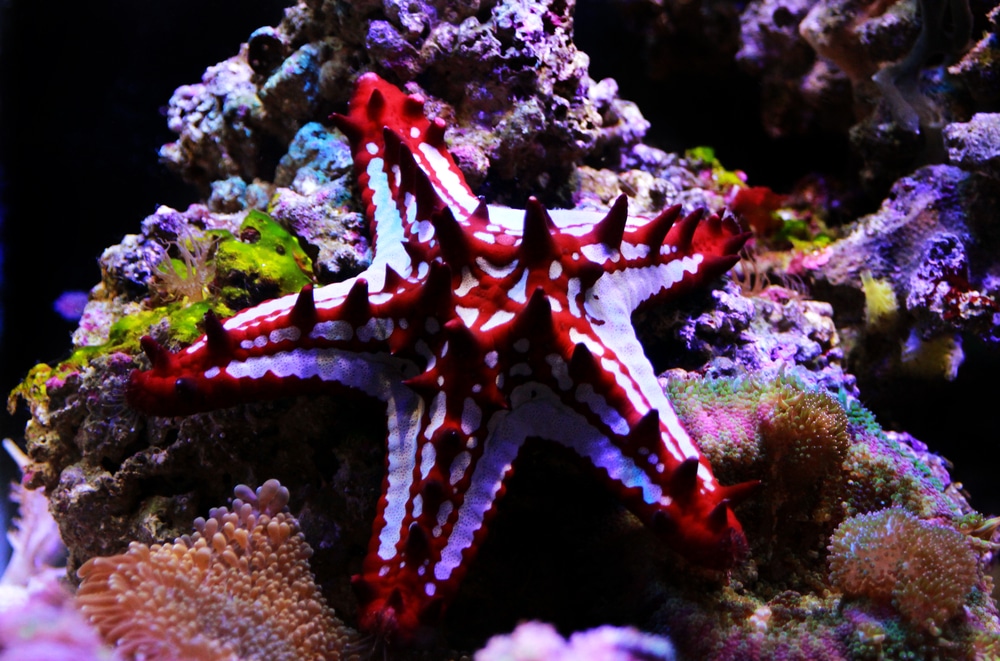
Red Knobbed Starfish are similar in care requirements to their close cousin the Chocolate Chip Starfish. Red Knobbed are one of the more attractive types of aquarium Starfish, with vivid scarlet protrusions on a grey background.
While significantly more expensive than Chocolate Chip stars, Red Knobbed Starfish are just as easy to care for. They will happily accept chunks of fresh shrimp, fish, mussel, thawed cubes of Brine Shrimp, and other typical aquarium fare.
As eager as they are to eat, they are unfortunately not reef safe and will consume anemones, soft corals, and other invertebrates they come across. However, their spines and chemical defenses make them great additions to fish-only aquariums!
- Scientific Name: Protoreaster linckii
- Origin: IndoPacific
- Diameter: Up to 12 inches
- Difficulty: Easy
- Reef Safe: No
Basket Starfish
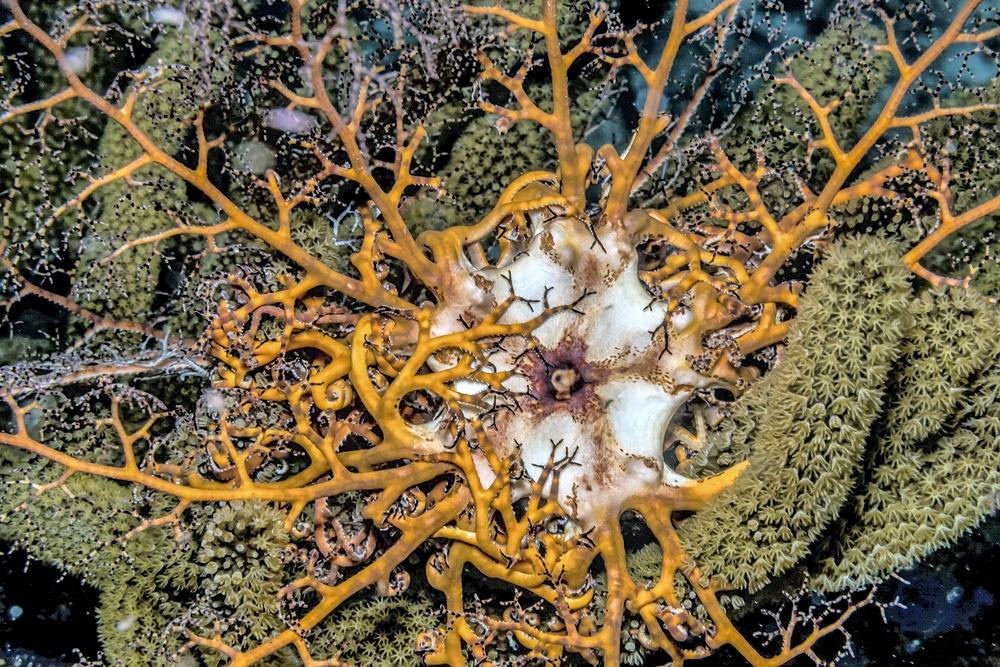
Basket Starfish are an example of how entangled Starfish classification truly is. While they are in the same class as Brittle Starfish they are different enough to warrant a significantly different grouping.
Basket Starfish are some of the most unusual invertebrates in the world. They are nocturnal filter feeders that reach out into the water column and use their finely branched limbs to sieve out plankton and other tiny prey.
During the day they tend to retreat into rocky crevices. While they can be trained to feed during the day it’s sometimes a lengthy, difficult process.
This means they need a constant stream of nutrients to feed on, which is a major impediment to water quality in the confines of an aquarium. Liquid filter feeder offerings, Brine Shrimp and Nauplii, Copepods, etc, are all eaten with gusto.
While some grow impressively large, they stress easily and can even damage or lose limbs if Basket Starfish rub up against aquarium glass continually. Keeping the largest species in large, mature aquariums of 180+ gallons is the only real way to keep these delicate creatures alive.
Other species stay much smaller and are suitable for mature, medium sized reef tanks!
- Scientific Name: suborder Euryalina
- Origin: Worldwide
- Diameter: Up to 2 feet
- Difficulty: Moderate to Difficult
- Reef Safe: Yes
Sand Sifting Starfish

As one of the most popular types of Aquarium Starfish, Sand Sifting Starfish are inexpensive, active, and interesting echinoderms that can find a place in most aquariums.
Sand Sifting Starfish aren’t difficult to keep; they are scavengers and detritivores that actively filter and sift through sand searching for fine particles of food, biofilms, small worms, and tiny invertebrates to devour. Even other tiny Starfish aren’t safe.
However, it’s worth mentioning that sand in an aquarium is meant to be a source of active decomposition and part of the overall filtration system of a healthy ecosystem. Sand Sifting Starfish will consume larger chunks of decomposing matter but they also actively disrupt the balance of live sand.
They are best for large aquariums with deep substrates that can tolerate the constant disruption. Or fish based ecosystems with adequate exterior filtration. Once substrate detritus begins to run thin you’ll need to provide supplemental feedings.
Otherwise your Sand Sifting Starfish will burrow unseen and eventually starve, creating a massive burst of ammonia and other toxic compounds.
- Scientific Name: Astropecten polyacanthus
- Origin: IndoPacific
- Diameter: 8 inches
- Difficulty: Easy
- Reef Safe: Yes
Serpent Starfish
Serpent Starfish are a genus of Brittle Starfish – while they are superficially similar, Serpent Starfish have entirely smooth limbs while Brittle Stars have spikes and bristles along their arms.
Their care requirements are identical; Serpent Starfish are nocturnal detritivores and scavengers, seeking out mostly dead prey, leftover food, and organic biofilms to consume.
They are fairly hardy, as Starfish go, and come in a variety of colors, with brown, black, and orange being the most common.
- Scientific Name: Ophioderma sp.
- Origin: Worldwide
- Diameter: Up to 12 inches
- Difficulty: Easy
- Reef Safe: Yes
Asterina Starfish
Asterina Starfish aren’t usually sold. They come as hitchhikers on live rock and stony coral purchases. While the majority feed on diatoms, detritus, and coralline algae, and are actually somewhat useful to reef aquariums, a few species attach to and nibble on corals and other sessile invertebrates.
The genus is diverse and it’s impossible to know whether you have a harmless species or coral predator until the attacks begin. Fortunately, they are tiny and won’t kill corals immediately.
Unfortunately, they reproduce asexually and extremely quickly. They shed limbs that quickly grow into mature Starfish that repeat the cycle. Mature aquariums rich in biofilms can grow hundreds of these tiny Starfish. And it only takes missing one for the cycle to begin anew!
The best control methods are to use Starfish-eating fish and invertebrates. The best by far are a mated pair of Harlequin Shrimp, specialized Starfish-eating crustaceans that can eliminate Asterina infestations in months.
- Scientific Name: Asterina sp.
- Origin: Worldwide
- Diameter: ½ inch
- Difficulty: Very Easy
- Reef Safe: With Caution
Feather Starfish
Also known as Sea Lilies, Feather Starfish belong to an ancient group of Echinoderms known as Crinoids. They are as close to aliens as you will ever get on this planet and even among Starfish they are strange to behold. Some species will even actively swim in the water column!
Much like Basket Stars, Feather Starfish are nocturnal suspension feeders. They pick out Copepods, Brine Shrimp Nauplii, plankton, and other near-microscopic floating foods from the water column. This means a frequent to constant stream of food, which can lead to major water quality issues in the closed system of an aquarium.
A high quality reef protein skimmer mitigates some of the potential issues with nitrogen decay byproducts and is essential for Basket and Feather Starfish care.
Still, they are incredibly sensitive and one of the most difficult marine organisms to keep alive. Even if you manage to gently introduce them into established reef aquariums and provide food and the current they love, they may die anyway, shedding limbs and growing pale until they simply disintegrate.
Being exclusively wild-caught, Feather Starfish often come with hitchhiking commensal organisms. Tiny squat lobsters, bristle worms, and other colonists may live among the arms of the Feather Starfish. Most of these creatures cause no harm and a few may even offer some unknown benefit.
- Scientific Name: class Crinoidea
- Origin: Worldwide
- Diameter: Up to 12 inches
- Difficulty: Very Difficult
- Reef Safe: Yes


What starfish can live in a 55 gallon tank aquarium